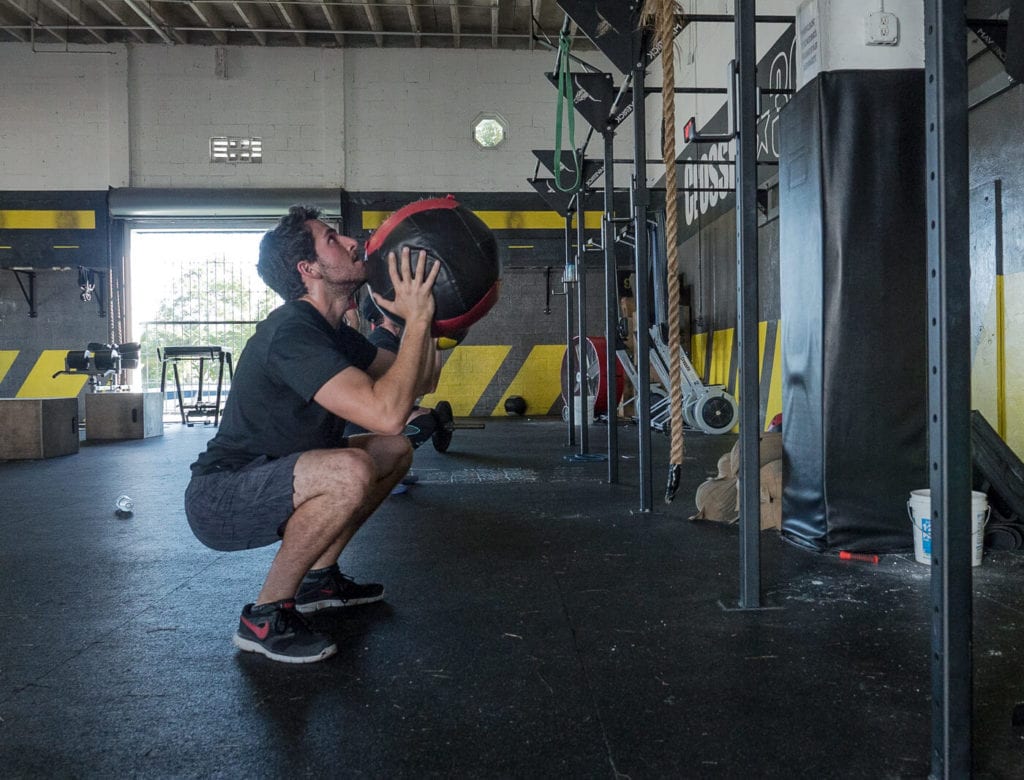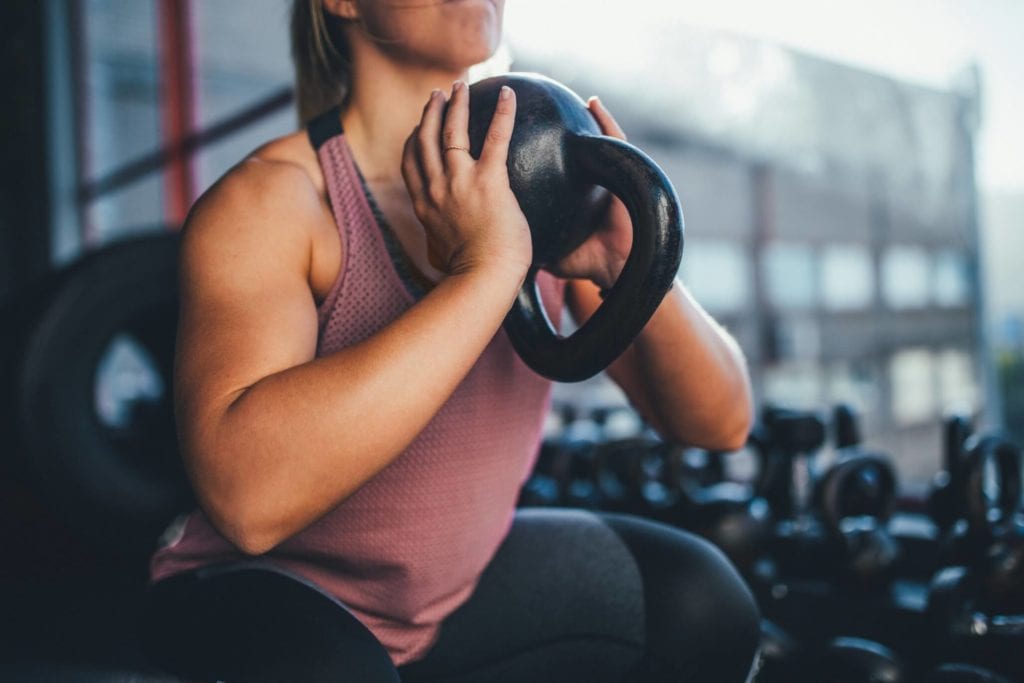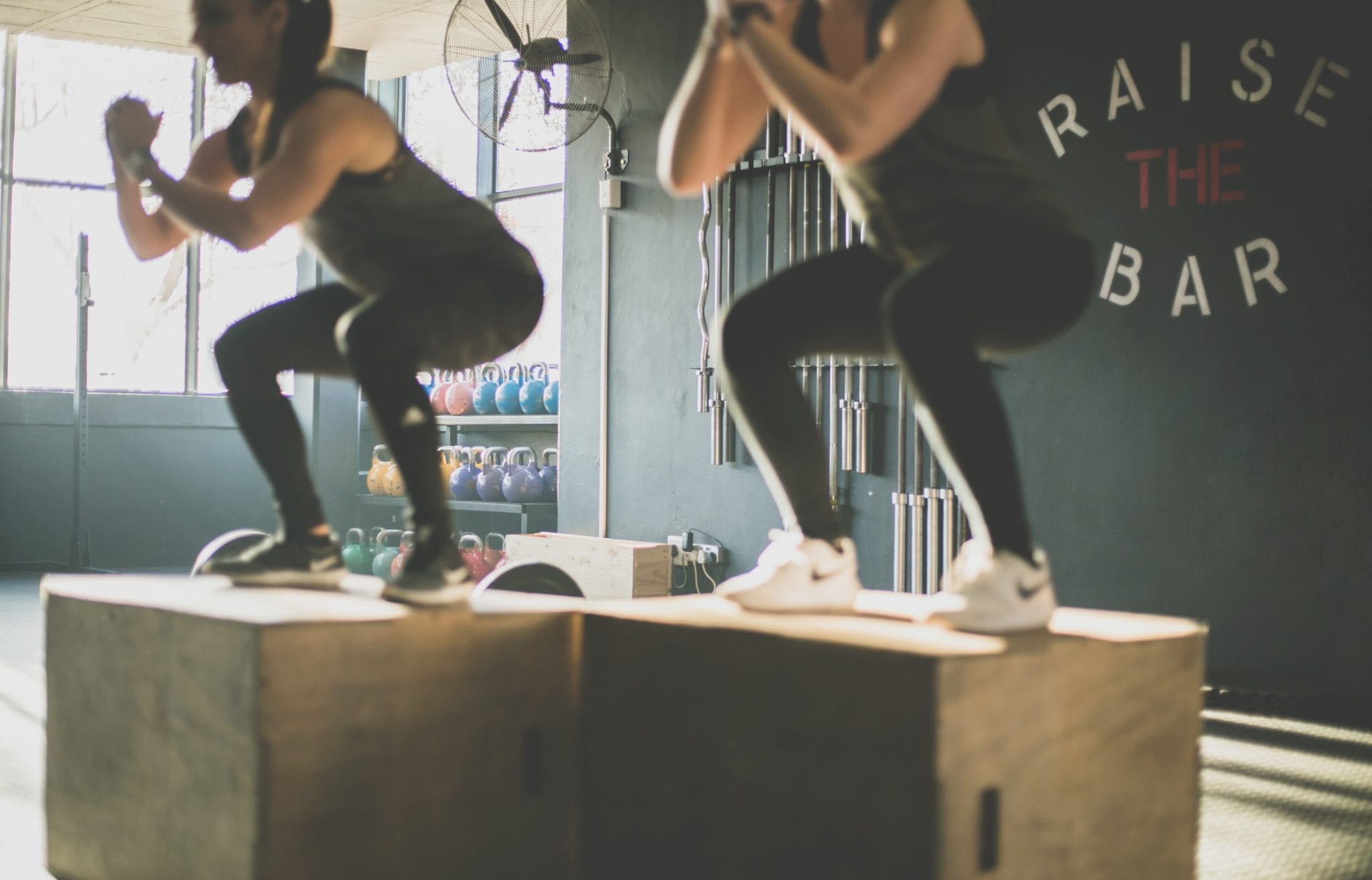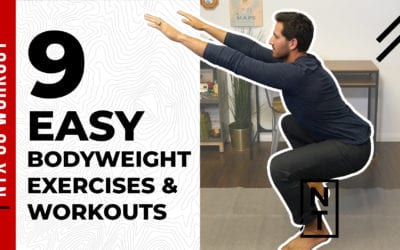If exercise had a magic pill it’d be called HIIT. Well, at least that’s what the magazine covers want you to believe. But how true is it? And what exactly is HIIT?
While I can tell you that HIIT stands for High-Intensity Interval Training, that doesn’t really explain what it is.
Quite simply, HIIT is a template for moving your body that gets results.
This guide is going to break down what HIIT is, how to find the right intensity for a HIIT workout, and how to get started doing HIIT workouts, whether it’s in a gym or at home.
Let’s get started.
What is High-Intensity Interval Training

Let’s break down each part of high-intensity interval training.
High-Intensity is Not Intensity at an 11
Intensity gets thrown around a lot. When you think of intensity you might picture a drill sergeant (say Full Metal Jacket‘s Gunnery Sergeant Hartman) yelling at you to do 50 push-ups. That may be emotionally intense but it’s not necessarily high intensity in terms of working out.
Think of intensity like your body’s speedometer. Low intensity is going for a walk or slowly lifting light weights. Your heart rate won’t go up that much. You’ll still be able to easily breathe.
Now if we increase the speed and go to a higher intensity, say a sprint or quickly lifting a moderate weight, our heart rate will increase, our breathing will quicken, our muscles will start to fatigue.
Intensity is Relative
It doesn’t even matter what type of movement you do, you can do the same movement at low or high intensity. Take our 50 push-ups from Sergeant Hartman. If he’s feeling generous and tells us to take our time with the 50 push-ups, we might do five, rest a few minutes, do a few more. Sure, it’s work, but our heart rate isn’t elevating and we can still hold a conversation.
Now imagine he’s in your face and telling you to do those 50 push-ups as fast as possible. You’re moving much quicker and doing much bigger sets of push-ups. Your heart rate is shooting up, you’re trying to get enough oxygen with each breath. You are now performing a movement at high intensity.
But here’s the thing: intensity is relative.
Going back to my first low-intensity example of a walk; for some people that might be a high-intensity activity, especially if they are coming from an inactive lifestyle. And that’s ok. Your body will adapt and what was once a ‘high-intensity’ activity will start to feel relatively easier (the key is to keep pushing the intensity – more on that later).
Intensity is what creates the adaptations we’re looking for (getting stronger, fitter, leaner) in the quickest and most efficient way possible.
It’s the secret sauce that makes the magic happen.
Intervals: The Best of Both Worlds
Intervals are simply splitting up the workout into blocks of time. Some blocks we work, some blocks we rest or do a less intense activity. Intervals are key in developing your cardiovascular system (stronger heart, better endurance) without sacrificing developing strength, speed, and power. Basically we get the best of both worlds in training.
The key is to make sure the rest periods are measured and specific. It’s not “rest until you fully recover,” it’s rest for a specific amount of time to partially recover. As Lon Kilgore writes in FIT, “rest intervals should only enable completion of the programmed amounts of work NOT provide for complete recovery.”
Over time, you will train your body to recover faster. “One of the single biggest measures in aerobic fitness is how fast you can recover,” says Aerobic Capacity coach Chris Hinshaw.
As an example of what a work/rest format might look like, a popular HIIT format is the Tabata Protocol. It’s 20 seconds of a movement as fast as possible, 10 seconds of rest, repeated 8 times (4 minutes total).
Training with a Purpose
Training encapsulates everything that we’re doing, both in the micro of a singular training session and the macro of our larger goals, whether that’s just overall wellness or specific to a target, like a marathon, obstacle course, or sport.
We want each session to be varied enough to fit into a larger plan. Different movements, different interval times, different intensity goals, different overall durations. We’ve got a plan of what we want to achieve in a workout session that fits in with our larger goals.
HIIT vs Cardio

HIIT versus ‘cardio’ is a constant point of confusion, as if you have to choose between one of the other. HIIT is looked at as the crazy fast workout while cardio is seen as a light jog or hour on the Stairmaster.
Here’s the thing: HIIT is cardio when your workout session is long enough.
In the first few minutes of starting a workout, our body relies on our anaerobic energy systems or the systems that don’t need oxygen. That would be our phosphagen and glycolytic pathways. This provides explosive, high powered energy, but it gets depleted after just a few minutes.
The rest intervals in HIIT are designed to help us catch our breath and replenish some of the anaerobic energy stores we used up at the beginning of the workout, but it’s never going be the same as when we just started working out.
Once our workout goes beyond a few minutes (which chances are, it will) your body relies on its oxidative pathway for energy. Basically, air. This is what we’d traditionally call ‘cardio.’
So whether you’re doing HIIT or ‘cardio,’ your body doesn’t know the difference or care. It’s all the same.
The Benefits of HIIT

HIIT’s secret sauce is doing regular movements at a higher intensity. It’s what helps you get better results in less time.
The magic of HIIT is even with the shorter workouts, your body gets better at doing longer activities. As Kilgore says in FIT, “Training that consistently includes high-intensity work performed for periods of four to ten minutes will improve the ability to do sustained lower intensity work that lasts for twenty, thirty, and even forty minutes.”
Even with the shorter workout formats, you’ll improve your performance at longer activities.
Training that consistently includes high-intensity work performed for periods of four to ten minutes will improve the ability to do sustained lower intensity work that lasts for twenty, thirty, and even forty minutes.
Lon Kilgore, FIT
HIIT for Burning Fat
One of the biggest benefits mentioned about HIIT is its fat-burning benefits. It’s not just marketing hype, there is science to back this.
In a study by Angelo Tremblay, Ph.D., two groups of inactive adults did a 15+ week training program. One group did traditional endurance training, cycling at about 60% Heart Rate Reserve (see below) while the other group did a high-intensity training format.
Even though the scientists calculated that the endurance group burned more than twice as many calories as the HIIT group (since they spent more time actually doing work), the HIIT group lost 9 times more fat than the endurance group (another reason that paying attention to calories is a waste of time, but that’s another article).
Not only does it burn more fat on a cellular level, but HIIT workouts have also been shown to increase mitochondrial density. More mitochondria mean more energy and stronger muscles.
Goal Heart Rate for HIIT

You shouldn’t worry much about hitting a specific heart rate number to make sure you’re hitting the right intensity. If you feel your heart beating in your chest, you’re taking quick, deep breaths, and it’d be really hard for you to hold a conversation, you’re probably hitting the right intensity.
But for those of you who are data nerds and want to check your Apple Watch or heart rate monitor, here’s one of the more reliable ways to figure out your target heart rate.
Karvonen Formula1
High-intensity or vigorous activity is considered 70-85% of training intensity, which is based off your Heart Rate Reserve (or HRR. The range between your Resting Heart Rate and Max Heart Rate).
I’m going to break down the Karvonen formula which is used to calculate your HRR, but if you don’t care about the math you can just skip below to our HRR calculator.
So first let’s start with your Max Heart Rate. The accepted estimate is to take 220 and subtract your age.
Next, figure out your Resting Heart Rate. Best time to measure this is right after you wake up.
Now take the Max Heart Rate and subtract your Resting Heart Rate to get your Heart Rate Reserve.
Now multiply the Heart Rate Reserve by .7 (for 70%), then add that number back on to your Resting Heart Rate. Now you have your Target Heart Rate! Once you go past this number you are (theoretically) doing vigorous activity. You can set up your Apple Watch to alert you when you go past this number.
Math not your strong suit? Just fill out the calculator below.
Target Heart Rate Calculator
Don’t use this number as the definitive red line between high and low intensity. Trust your body first, not some device. And always check with your doctor before starting any type of vigorous activity.
Getting the Most Out of HIIT

Constant Adaptations
The key to keeping HIIT workouts effective is to keep mixing things up and keep pushing.
Remember the walking example earlier where for some people just walking for a mile might be high-intensity. Well if they consistently walk, soon walking will be low intensity for them. So to maintain the relative intensity, that walk needs to turn into a jog which then turns into a run.
The same idea applies to what type of movements you do, how long you do them, how long you rest, how long your overall workout is. As Greg Glassman put it in What is Fitness?, “Don’t subscribe to high reps, or low reps, or long rests, or short rests, but strive for variance.”
Should You Do HIIT Every Day?
To see any lasting improvements, three workouts a week is really the bare minimum. Five is better. Now, this doesn’t mean going full throttle five days a week. Some days should be shorter, faster workouts while others are longer and a bit less intense.
Rest and recovery are vital
When it comes to working out every day, there’s a limit to ‘more is better.’
Rest and recovery are vital. Workouts cause positive stress to our body. Rest is when our body recovers, our muscle tissue repairs itself, and the improvements happen (stronger muscles, improved aerobic capacity, better cardiovascular performance).
Getting Started with HIIT

If all this sounds exciting and you want to start incorporating HIIT style workouts in your training, there are a few things to keep in mind, especially with volume (the total amount of work you do) and scaling.
HIIT in a Studio
A great place to start is in a studio setting, such as a CrossFit or functional training space. The premium you’re paying is not for the space or equipment but proper coaching.
CrossFit workouts are programmed for the top person in the gym. You’re supposed to scale. It’s kind of a silly way to go about it, but keep this in mind when looking at the workouts (some gyms have started removing weight numbers altogether).
The coach should help you modify the workout to your abilities. If you have questions, ask. You’re looking for an intense but doable workout. Focus on the mechanics of a movement first before making it more intense, especially when weight is involved.
Another point for scaling is volume. If the workout has 6 rounds of 25 squats, that’s a total of 150 squats. That’s a lot of squatting if you’re just starting out. 10 or 15 might be a more appropriate number for the workout.
Remember, intensity is relative. And even though there’s a leaderboard, in reality it’s you against you. Don’t worry about the person next to you. You just want to be better than yesterday.
A good coach should go over all of this with you. If they’re not, think about looking for another studio.
HIIT at a Gym
A gym will have all the equipment you need to get some great workouts in (even a hotel gym). What it lacks is coaching and instruction, especially if the movements are new to you. Consider hiring a personal trainer for a few sessions to get started before working out on your own.
There’s also plenty of online resources, including a form check subreddit and online resources.
You can easily adapt any workout to an interval format you do at high-intensity. Instead of a leisurely 3 x 5 sets of back squats, do the back squats and then do as many pull-ups (or rows) as possible before resting a minute and repeating (however squat with a much lower weight than normal).
HIIT at Home
If you’re just beginning a workout routine, or have a crazy busy schedule, getting into a gym or studio might be too intimidating or not an option.
You can easily do HIIT at home by focusing on bodyweight movements. Down the line, you can up your game with dumbbells or a kettlebell.
Check out our library of free HIIT workouts you can do anywhere. If you’re looking for a daily program, check out NTX Go, where we send you a different workout with instructional videos every single day.
Wrap Up
I hope this sheds some light and clears up any confusion on what exactly is going on with a HIIT style workout. Have you done HIIT before? What’s been your experience? Any questions you still have that I didn’t address? Leave them in the comments below!




0 Comments